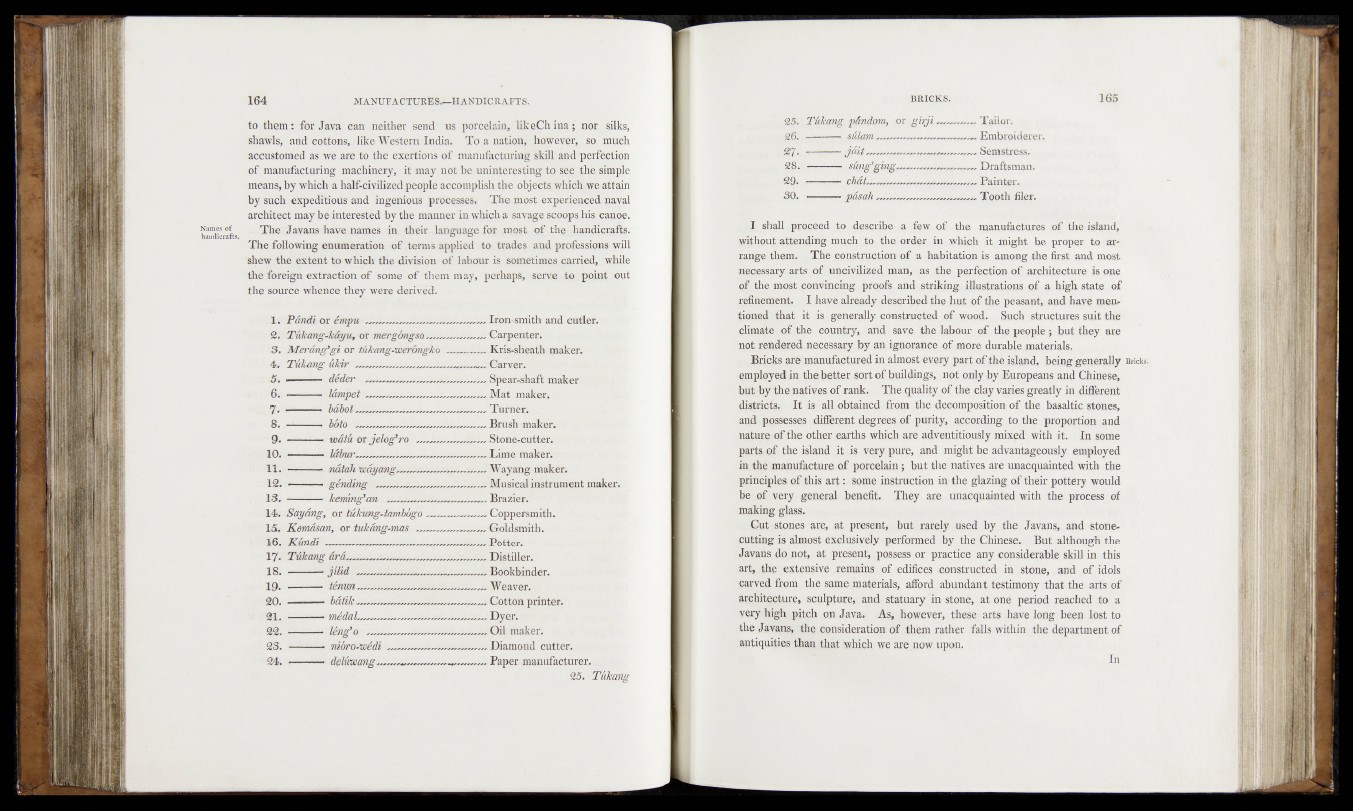
to them: for Java can neither' send us porcelain, likveCh ina ; nor silks,
shawls, and cottons, like Westernrlndia, To a nation,. hpwever, so much
accustomed as we are to the exertions of manufacturing skill and perfection
of manufacturing machinery, it may not be uninteresting to see ,the, simple
means, by which a half-civilized people accomplish the objects which we attain-
by such expeditious and ingenious processes. The most experienced naval
architect may be interested by the manner in which a savage scoops his canoe.
. The Javans have names in their language for most of the handicrafts.
The following enumeration of terms applied to trades and professions will
shew the extent to which the division of labour is sometimes carried, viilite
the foreign extraction of some-of them may, perhaps, serve to jiojnt out
the source whence they were derived.
1 . Pândi or émpu
2. Tûkang-kâyu, or mergongsa^^
3. Merânffgi or tûkang-'oeerôngko
4. Tûlamg. ûkhr
6. lâmpet
7 . ------- bâbot
8. • '• • • • . bôto
9- — ■ ' - - wâtû or jelog’ro —
10. » ■ . "
11. —------ ^ natak ivaycmg^^
12. —■■■■■ génding
13. —....■— keming’an
14. Sayârig, or tukung-tambôgo__
15. Kemâsan, or tukang-mas
16. Mundi
17- Tékemg ârâi.
18. .. . — jtttd
19v —— ténun„
20. --------- battle,
21. ---------médal„„„,„
22. ------- léng’o —
23. ------— niôro-'wédi
24. ......... delvmang^
__ Iron-smith and cutler.
Carpenter, j
Kris-sheath maker.
Carver.
Spear-shaft maker
____Mat maker;
Thin»Ei_^_'.
^ ^ . firush maker.
. Stone-cutter.
,__ _ Lime maker.
Wayang maker.
^ __, Musical instrument maker.
,_Brazier. - I
™ Coppersmith.
Goldsmith.
L«. Potter.
«----- Distiller.
------ Bookbinder.
Weaver,
Cotton printer.
^^wDyer. -
___Oil maker. .
—— Diamond cutter.
Paper manufacture
25. Tiikafis
,. . 25. T&Jcang pandora, or g irji___ _ Tailor.
.j 26, ——— - sMern Embroiderer.
27. -• — — ~ S e m s t r e s s .
------- » sung’g h i g ^ i ^ ^ ^ ^ ^ ^ Draftsman.-' ■
- - 29. --------- Painter.
80, pasah Topth jjjgp
I shall proceed to /de.sgijibCja few qf ..the manufactures of the island,
without attending much to the order in wlfigh it might be proper to arrange
them. The construction pf a habitation is among the first and most
necessary arts of uncivilised man, as the perfection of architecture is ope
of the most convincing proofs and striking illustrations pf a high state of
refinement, I have already described the but pf the peasant, and have mentioned
that it is generally constructed pf wood, Such structures suit the
climate of the country, and save the labour of the people $ but they are
not rendered necessary by an ignorance pf more durable materials.
Bricks arp' manufactured in almost every part of the island, being generally
employed in the better sort-of buildings, not only by Europeans and Chinese,
but by the natives of rank. The quality of the cjay varies greatly in different
districts. If is all obtained from the decomposition of the basaltic stones,
and possesses different degrees of purity, according to the proportion and
nature of the other earths which are adventitiously mixed with it. In seme
parts of the island it is very pure, and might be advantageously employed
in the manufacture of porcelain; but the natives are unacquainted with the
principles of this a r t: some instruction in the glazing of their pottery would
be of very general benefit. They are unacquainted with the process of
making glass.
Cut stones are, at present, but rarely used by the Javans, and stonecutting
is almost exclusively performed by the Chinese. But although the
Jayans do not, at present, possess or practice any considerable skill in this
art, the extensive remains of edifices constructed in stone, and of idols
carved from the same materials, afford abundant testimony that the arts of
aFPBitfpfure, sculpture, and statuary in stone, at one period reached to a
very high pitch pn Java. As, however, these arts have long beep lost to
the Javans, the .consideration of them rather falls within the department of
antiquities than that which we are now upon.
In